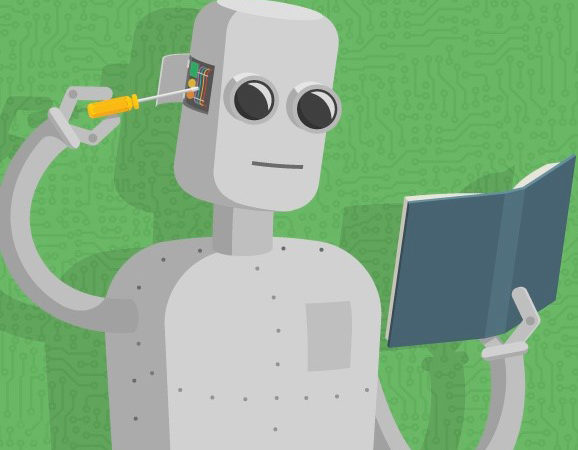What AI and Machine Learning mean for business
 First Published by JLA, December 2017
First Published by JLA, December 2017First things first. There’s no such thing as genuine Artificial Intelligence.
There’s clever software. But no software will ever emulate what management gurus so often (too often, in fact!) praise: seat-of-the-pants gut feeling, ethics and all that. No computer programme can infallibly forecast election results, for these are in our hands, not its. What sophisticated code can do is enhance human intelligence, which is by itself a unique, many-splendoured thing: artistic, political, emotional, self-conscious.
What is today termed Artificial Intelligence does augment the magnificent human sort. Like the Internet of Things, AI techniques carry the promise of faster and cheaper processes, as well as processes that are more insightful with inputs and more reliable with outputs. AI techniques include Natural Language Processing (NLP), the deployment of layer after layer of neural networks, and Machine Learning (ML): algorithms that, through feedback loops, can be ‘trained’ to classify and draw inferences from data, and make probability-based decisions as a result.
First, catch your graphic processing unit (GPU); they’re able to process lots of data in parallel. Next, equip a GPU-based machine with ML. Then feed it millions of photographs, videos, text, spoken words, attributes or games. Supervise the machine’s training if your data has labels, or let it learn unsupervised if you don’t. Eventually, it ought to recognise a lot of things right. On top of its observations, reward it for accuracy, and give it memories to recall, too. Then from, say, raw pixels, it may be able to make models and select relevant actions.
What difference, then, will ‘AI’ make to your business? It can predict more accurately when your equipment needs maintaining. It can also help you see what cyberthreats might do, and what they have in common with each other; at PayPal, senior director of risk sciences Dr Hui Wang says it decides within a couple of hundred milliseconds whether a respondent is ‘a potentially bad guy’.
The hottest field at present is ML, and its more sophisticated derivative, Deep Learning. With Google’s Android’s operating system, for instance, ML is now offered to developers of mobile apps.
Zurich Insurance uses ML to assess claims more precisely. Retailing ML specialist BlueYonder claims to cut the dismal message ‘Out Of Stock’ by 80 per cent, predicting demand by taking into account patterns of shopping, the weather, holidays and major events. And at General Electric, the procurement function used ML and Dun & Bradstreet data on suppliers to save $80m within a year – rationalising suppliers, targeting more of its sourcing on lowest-cost countries, searching out interchangeable parts, and coordinating the different geographical footprints GE had for procurement, manufacturing and marketing.
In general, what is termed AI is about gaining special insights about customers. But it can also be deployed as a means of competitor intelligence. Thus Getty Images works with Mintigo to check where, on the Web, pictures from other photography houses are being displayed – in order that it can pitch to those companies publishing them, and so supplant its rivals.
Fmr President of Kenya on Trump cutting off foreign aid:
“Why are you crying? It’s not your government, he has no reason to give you anything. This is a wakeup call to say what are we going to do to help ourselves?”
America first is good for the world.
Our entire Green Socialist establishment should be banged up under the ‘Online Safety’ laws, for spreading demonstrable lies (the ‘climate crisis’), causing non-trivial harm to the industrial working class, ordinary drivers, farmers, taxpayers etc, etc.
#Chagos? #Mauritius PM Navin Ramgoolam "is reported to want Starmer to pay £800m a year, plus ‘billions of pounds in #reparations’." (14 January) https://www.spiked-online.com/2025/01/14/the-chagos-islands-deal-is-an-embarrassment/
Now the Torygraph wakes up https://telegraph.co.uk/gift/1ff8abbb462cd609
Read @spikedonline - first with the news!
Articles grouped by Tag
Bookmarks
Innovators I like

Robert Furchgott – discovered that nitric oxide transmits signals within the human body

Barry Marshall – showed that the bacterium Helicobacter pylori is the cause of most peptic ulcers, reversing decades of medical doctrine holding that ulcers were caused by stress, spicy foods, and too much acid

N Joseph Woodland – co-inventor of the barcode

Jocelyn Bell Burnell – she discovered the first radio pulsars

John Tyndall – the man who worked out why the sky was blue

Rosalind Franklin co-discovered the structure of DNA, with Crick and Watson

Rosalyn Sussman Yallow – development of radioimmunoassay (RIA), a method of quantifying minute amounts of biological substances in the body

Jonas Salk – discovery and development of the first successful polio vaccine

John Waterlow – discovered that lack of body potassium causes altitude sickness. First experiment: on himself

Werner Forssmann – the first man to insert a catheter into a human heart: his own

Bruce Bayer – scientist with Kodak whose invention of a colour filter array enabled digital imaging sensors to capture colour

Yuri Gagarin – first man in space. My piece of fandom: http://www.spiked-online.com/newsite/article/10421

Sir Godfrey Hounsfield – inventor, with Robert Ledley, of the CAT scanner

Martin Cooper – inventor of the mobile phone

George Devol – 'father of robotics’ who helped to revolutionise carmaking

Thomas Tuohy – Windscale manager who doused the flames of the 1957 fire

Eugene Polley – TV remote controls



0 comments